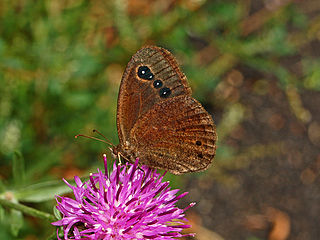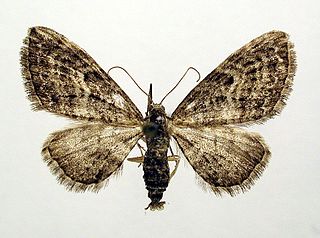
Eupithecia is a large genus of moths of the family Geometridae. There are hundreds of described species, found in all parts of the world, and new species are discovered on a regular basis.

The foxglove pug is a moth of the family Geometridae. It has a scattered distribution across Europe, closely following the range of its food plant. Where present it can be very common. The nominate subspecies E. pulchellata pulchellata is found in the British Isles, in Central Europe the subspecies is E. pulchellata intermedia. In the Pyrenees, it occurs to a height of 2,400 metres.

The lime-speck pug is a moth of the family Geometridae. It is a common species throughout the Palearctic region, the Near East and North Africa.

The common pug(Eupithecia vulgata) is a moth of the family Geometridae. It is a common species across the Palearctic region, the Near East and North Africa. It ranges from the Atlantic coast of Ireland and Portugal across Europe, the Middle East and Central Asia to the Russian Far East (Priamurje) and Korea.

The juniper pug or juniper looper is a moth of the family Geometridae. The species was first described by Michael Denis and Ignaz Schiffermüller in 1775. It is found throughout the Palearctic and Nearctic regions and the Near East.

Satyrus is a genus of butterflies from the subfamily Satyrinae in the family Nymphalidae. The genus was erected by Pierre André Latreille in 1810. The species in the genus Satyrus occur in Europe and North Africa.

The larch pug is a moth of the family Geometridae. The species can be found in Europe, the Ural Mountains, West and Central Siberia, the Altai Mountains, Transbaikalia, Yakutia, the Far East, Mongolia, Korea, Japan and in North America, from Yukon and Newfoundland to New York and Arizona.

Eupithecia simpliciata, the plain pug, is a moth of the family Geometridae. It is found in the Palearctic realm, from western Europe to north-western China (Xinjiang).
Parocneria is a genus of tussock moths in the family Erebidae. The genus was erected by Harrison Gray Dyar Jr. in 1897.

Eupithecia venosata, the netted pug, is a moth of the family Geometridae. It was first described by Johan Christian Fabricius in 1787. It is found across the Palearctic realm from Portugal and Morocco in the west to the Lake Baikal in Siberia and Afghanistan and Pakistan in the east.

Auchmis detersa is a moth of the family Noctuidae first described by Eugenius Johann Christoph Esper in 1791. It is found from north-western Africa through southern and central Europe to Anatolia, Iran, Afghanistan and through Siberia to Lake Baikal.

Dyspessa is a genus of moths belonging to the family Cossidae. It was described by Jacob Hübner in 1820.

Eupithecia distinctaria, the thyme pug, is a moth of the family Geometridae. It is found throughout Europe. It is also found in Iran.
Eupithecia sperryi is a moth in the family Geometridae. It is found in the US state of New Mexico and the White Mountain region of Arizona.
Eupithecia semigraphata is a moth in the family Geometridae. It is found from most of Europe to the Caucasus and Armenia. It is also present on the Canary Islands and North Africa.
Eupithecia undulifera is a moth in the family Geometridae. It is found in Iran.
Eupithecia amurensis is a moth in the family Geometridae. It is found in Russia.
Eupithecia ochroriguata is a moth in the family Geometridae. It is found in Libya.
Eupithecia retusa is a moth in the family Geometridae. It is found in Libya.











